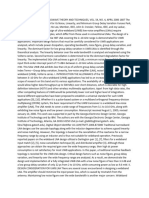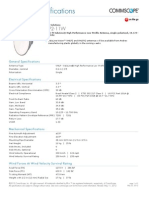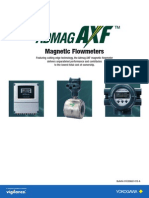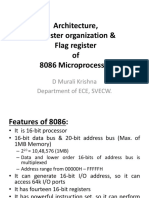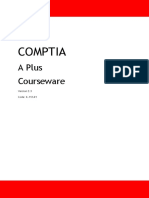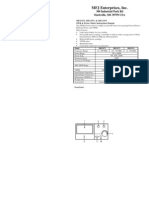Attenuators: Quick Reference Guide
Attenuators: Quick Reference Guide
Uploaded by
Lestary YennyCopyright:
Available Formats
Attenuators: Quick Reference Guide
Attenuators: Quick Reference Guide
Uploaded by
Lestary YennyOriginal Title
Copyright
Available Formats
Share this document
Did you find this document useful?
Is this content inappropriate?
Copyright:
Available Formats
Attenuators: Quick Reference Guide
Attenuators: Quick Reference Guide
Uploaded by
Lestary YennyCopyright:
Available Formats
dept26 Products
Passive Components
RF Switching Products
Fiber Optic Products
Active Components
Power Meters and Monitors
SatCom Products
RF Safety Test Solutions
Attenuators
50 Years of
Excellence
Quick Reference Guide
FREQUENCY RANGE GHz Standard Models
DC-40 DC-18 DC-18 DC-18 DC-18 DC-18 DC-18 DC-18 DC-18 DC-18 DC-18 DC-18 DC-18 DC-12.4 DC-12.4 DC-12.4 DC-11 DC-6 DC-6
CONNECTOR
2.9 mm Type N Type N Type N Type N Type N Type N SMA SMA SMA SMA SMA SMA Type N SMA SMA Type N SMA Type N
MODEL NO.
4768 776C 741 743-60 745-69 779 757C 4741 4743-60 4745-69 4779 4782 4776 777C 4778 4775 768 4780 773
PG. NO.
66 72 81 81 81 64 65 81 81 81 67 69 70 64 68 70 73 69 65
FREQUENCY RANGE GHz
DC-6 DC-6 DC-6 DC-5 DC-4 DC-3 2-12.4 2-12.4 4-18 4-8 4-8 7-26.5 7-18 12.4-18
CONNECTOR
SMA SMA Type N Type N Type N Type N Type N Type N Type N Type N Type N 3.5mm Type N SMA
MODEL NO.
4772 4774 769 765 766 752 791F 792F 4799 793F 794F 4796 4798 4797
PG. NO.
68 71 75 73 73 63 79 79 77 80 80 77 77 77
Attenuator Sets
DC-18 DC-12.4 DC-12.4 120A/4 119A/4 118A/4 76 76 76
Environmental Performance for Selected Passive Products*
Parameter Operating Temperature Storage Temperature Humidity Shock Altitude Vibration Thermal Shock Specification -54 to +105C -55 to +125C Per MIL-STD-202F, method 103B, condition B (96 hours at 95% R.H.) Per MIL-STD-202F, method 213B, condition J (30G, 11 msec) Per MIL-STD-202F, method 105G, condition B (50,000 feet) Per MIL-STD-202F, method 204D, condition B (.06" double amplitude or 15G, which ever is less) Per MIL-STD-202F, method 107D, condition A (5 cycles)
*Applicable to Stripline Directional Couplers, Attenuators, Power Dividers Note: This is an exclusive listing. Where otherwise noted in the catalog, the above environmental performance may not apply. Not applicable for those products designed for commercial applications. Many of our catalog off-the-shelf (COTS) products have the ability to withstand considerably more stringent environments. If you have special environmental requirements, please contact the Sales Department at Narda. 58
435 MORELAND ROAD HAUPPAUGE, NY 11788 USA TEL: (1) 631 231-1700 INTL TEL: (1) 631 231-1390 FAX (1) 631 231-1711 E-MAIL: nardaeast@L-3COM.com www.nardamicrowave.com
RF Safety Test Solutions
SatCom Products
Power Meters and Monitors
Active Components
Fiber Optic Products
RF Switching Products
Passive Components
dept26 Products
50 Years of
Excellence
Coaxial attenuators are used in every type of equipment involving the transmission, control, or measurement of microwave energy. To meet the needs of system designers, original equipment manufacturers, and laboratory users, our variety of devices offers an almost limitless combination of physical and electrical performance characteristics. Narda offers attenuators for frequency bands from DC to 40 GHz, with a choice of attenuation values from 0 to 69 dB, average power ratings from 0.5 to 150 watts, and flatness specifications to 0.2 dB. Variable attenuators encompassing many combinations of bandwidth, attenuation range, accuracy, power handling capability, and physical dimensions are also available.
Attenuators
attenuators, low loss cutoff attenuators, step (or turret) attenuators and voltage-controllable attenuators. The general operating principles and characteristics of each of these types are described below.
Lossy Wall Attenuators
Figure 1 shows a section of the lossy wall attenuator. The construction is basically stripline with a section of the outer conducting wall replaced by a section of lossy material with high dielectric and magnetic dissipation factors. Microwave power flowing through this dielectric material is attenuated as a result of loss, allowing low variation of attenuation with frequency. Attenuation is varied by mechanically varying the location of the lossy material with respect to the fixed center conductor. In practice, the outer walls are displaced in such a way that the physical length of the transmission line is constant. Various coaxial line geometries are employed to provide gradual variation of attenuation with mechanical movement and to achieve the required flatness with frequency. Limitations of available lossy materials restrict the usefulness of these attenuators to above 2 GHz, although they can be used with degraded performance to 1 GHz. Because the dissipation of energy in these lossy materials tends to be frequency sensitive, selection of a lossy wall attenuator usually involves a tradeoff of attenuation, bandwidth and flatness versus frequency range and size. For example, assuming one available model provides 90 dB of attenuation at 16 GHz, with a design center from 15.7 to 16.3 GHz. The same unit can be used in X-band, but with attenuation reduced to about 50 dB. These units have moderate power-handling capability since attenuation is achieved through dissipation of power as heat in the walls. Narda lossy-wall attenuators can easily handle an average power of as much as 10 watts and peak power to 5 kW. In general, lossy-wall attenuators have low insertion loss (usually less than 1 dB), low VSWR, and relatively flat attenuation characteristics over the design band. Attenuation is directly proportional to the length of the center conductor between the lossy material. Consequently, the designer concerned about space limitations can safely estimate that a 40 dB unit will be approximately twice the size of 20 dB unit. Lossy wall attenuators are ideally suited for use as buffers in front of a local oscillator or power source, where the requirement is for a minimum of 10 dB of attenuation with capability for precise tuning. Common applications are in surveillance, and in radar reflection augmenters, where each of many local oscillators must be trimmed a few dB. For these and similar applications, the lossy wall attenuator offers cost and size advantages over other types of variable attenuators.
Attenuators For Systems Applications
The most common applications for coaxial attenuators in microwave systems are in transmitters and receivers. In these, and similar applications, the characteristics that are usually of principal concern are: a) amount or range of attenuation b) flatness with frequency c) average and peak power-handling capability d) temperature characteristics, and e) size and weight
Fixed Attenuators
Fixed attenuators are used in systems for two broad classes of service. One is in a calibration channel to establish a known signal level; flatness over the required frequency range is important here. In the second type of service, the device is used for impedance matching or as a buffer to prevent interaction between two devices. For this type of service, low VSWR is the important factor. The variety of fixed attenuators for these applications is shown in this catalog. Although these attenuators cover most requirements for frequency range and flatness, the practical rule, where cost is a factor, is to specify only the range and tolerances that are required. Since these attenuators are manufactured by thin-film deposition, savings resulting from unique specifications will not be significant for single units or small quantities, but should be considered for large quantities.
Variable Attenuators
Variable attenuators for systems applications (and some OEM and laboratory applications) fall into five general categories: lossy wall attenuators, variable coupler
435 MORELAND ROAD HAUPPAUGE, NY 11788 USA TEL: (1) 631 231-1700 INTL TEL: (1) 631 231-1390 FAX (1) 631 231-1711 E-MAIL: nardaeast@L-3COM.com www.nardamicrowave.com
59
dept26 Products
Passive Components
RF Switching Products
Fiber Optic Products
Active Components
Power Meters and Monitors
SatCom Products
RF Safety Test Solutions
Attenuators
50 Years of
Excellence
desired attenuation range with resettability of better than 0.05 dB. Because of the inherent broadband characteristics of the thin-film, step attenuators afford excellent flatness from DC to above 18 GHz. Narda turret attenuators have a specified repeatability of 0.05 dB; in practice this figure is usually better than 0.02 dB. Life of the Narda turret attenuators can be expected to be in excess of one million steps.
Comparison Of Variable Attenuators
The suitability of several types of variable attenuators can be evaluated from Figure 2 (see next page). The performance characteristics given are for Narda attenuators.
Original Equipment Applications
For the original equipment designer, the ideal attenuator is likely to be a panel-mountable unit continuously variable from 0 to 69 dB, with maximum flatness over a wide frequency range. Since the present state-of-the-art is unable to provide devices with this combination of characteristics, equipment designers must choose a practical alternative. A step attenuator with a continuously variable attenuator to serve as a fill-in vernier between incremental steps over restricted frequency ranges will usually suffice.
Laboratory Applications
The selection of attenuators for use in the development laboratory is generally the easiest of the specification tasks. Because bench testing requirements may vary considerably from project to project, the objective in specifying attenuators for these applications will normally be to provide for the broadest possible range of project requirements. Characteristics involved in this concept of versatility will be: a) broad bandwidth b) large attenuation range c) high accuracy d) longevity of connectors
Figure 1. Transverse section of lossy wall attenuator at various stages of attenuation: (1) minimum attenuation; (2) small attenuation; (3) high attenuation; (4) maximum attenuation.
Step (Or Turret) Attenuators
For applications demanding both broadband flatness and adjustability over ranges from 0 to 69 dB, Narda has a number of stepping-type attenuators that utilize the flatness characteristics of thin-film fixed attenuators. The turret attenuator, Narda Model 745/4745 Series, is a typical example, using fixed attenuators mechanically arranged to permit successive stepping in discrete increments. Typically, these units are offered with switching in 10 or 1 dB increments and may be cascaded to provide the
Variable Attenuators For The Laboratory
The wide range of testing requirements usually dictates a selection of variable attenuators that remain flat over at least an octave, and frequently over several octaves. For this reason, the step attenuator represents a more practical choice
60
435 MORELAND ROAD HAUPPAUGE, NY 11788 USA TEL: (1) 631 231-1700 INTL TEL: (1) 631 231-1390 FAX (1) 631 231-1711 E-MAIL: nardaeast@L-3COM.com www.nardamicrowave.com
RF Safety Test Solutions
SatCom Products
Power Meters and Monitors
Active Components
Fiber Optic Products
RF Switching Products
Passive Components
dept26 Products
50 Years of
Excellence
Attenuators
Figure 2. Attenuation vs. Frequency of Variable Attenuators
than the low-loss, continuously-variable attenuator. Typical of step attenuators designed for bench test applications are the Narda Models 700/4700 Series. This series provides 0 to 60 dB attenuation in 10 dB steps; 0 to 9 and 0 to 69 dB attenuation in 1 dB steps. The series also includes effective zero-loss positions to permit full signal input to the load, providing convenient reference levels without removing the units from the setup. These units are usable as freestanding models, or in panel-mount configurations with behind-the-panel connectors.(Panel- mounting hardware is supplied as an accessory where applicable.)
The design and performance of Narda attenuators are suited to many high-reliability applications. In such cases, economical selection of attenuators can be achieved with Nardas assistance when the customer defines the requirement and application. Application-specific qualification inspections can be performed. This applies to both fixed and variable attenuators.
Connector Longevity
This is especially important in laboratory use, as worn or damaged connectors cause errors in attenuation and high VSWR. While many manufacturers supply stainless steel connectors on their better quality attenuators to provide longer life, all Narda standard line attenuators have stainless steel connectors.
Fixed Attenuators For Laboratory Setups
Fixed attenuators for laboratory service are available with various levels of calibration accuracy. The Attenuator Series, Model 777C for example, is available in eight standard attenuation values from 3 to 60 dB and is calibrated at DC, 4, 8, 10 and 12.4 GHz. Model 779 is available in 15 (standard) attenuation values from 1 to 60 dB and is calibrated at DC, 4, 8, 12.4 and 18 GHz. Attenuation certification for this series of attenuators is recorded at each frequency to the nearest .05 dB. The accuracy characteristics of these units are best suited to the standards laboratory, where they can be used under controlled conditions, rather than on the bench where other factors may cancel out the advantages to be gained from precise calibration and accuracy. For bench service, a more practical choice is the Narda 757C which covers the DC to 12.4 GHz band, has an average power capacity of 2 watts and is accurate to 0.3 dB; or the Narda 779 for DC to 18 GHz.
User-Manufacturer Consultation
Manufacturers of microwave components are often in a position to make recommendations regarding the selection of attenuators for particular applications. Narda offers consultation on any systems, original equipment or laboratory requirements and is prepared to assist in evaluating or specifying either catalog-listed or custom-designed attenuators for all application requirements. Theory and Practice of Attenuation Measurements In the use and design of microwave components it is often necessary to consider their insertion loss or attenuation characteristics. Insertion loss is the ratio of the power delivered to a matched load by a matched generator before and after the insertion of a component into the line. Insertion loss is actually a combination of two losses: mismatch loss (reflective) and attenuation (dissipative).
435 MORELAND ROAD HAUPPAUGE, NY 11788 USA TEL: (1) 631 231-1700 INTL TEL: (1) 631 231-1390 FAX (1) 631 231-1711 E-MAIL: nardaeast@L-3COM.com www.nardamicrowave.com
61
dept26 Products
Passive Components
RF Switching Products
Fiber Optic Products
Active Components
Power Meters and Monitors
SatCom Products
RF Safety Test Solutions
Attenuators
Mismatch loss is the ratio of power that would be absorbed by the device if it were perfectly matched to the actual power absorbed by the device with its mismatch in impedance. Attenuation is the ratio of power into a component to the power out under matched conditions, and represents the actual power dissipated within the component. Where a component is perfectly matched to the line and load, the mismatch loss is zero and insertion loss is the same as attenuation. The expression is the same for all three losses P a ( dB ) = 10 log 1 P2 but the variables have different significance for each case. For insertion loss, P1 is the power at the load before insertion of the component in the line and P2 is the power after insertion. In the case of attenuation, P1 is the power into the component and P2 is the power out. In practice, the insertion loss is usually of primary interest. It is good practice to provide a well matched generator and load. An attenuator with low VSWR is commonly used to obtain good source and load match.
50 Years of
Excellence
Figure 3. Engineer evaluating design at the HP8510B ANA
Data on individual attenuators can be supplied (for a nominal fee) upon request. For fixed attenuators, this is normally in tabular form as attenuation and two-ended VSWR vs. frequency, taken with an ANA. Resolution is 0.01 dB, and in hundredths for VSWR. In addition to microwave measurement, insertion loss can be measured at DC. The attenuator under test is placed between precise resistive terminations, and the dB value calculated from the drop-in load voltage read on a high-resolution digital voltmeter. Accuracy of DC attenuation is as follows: Attenuation to 10 dB to 40 dB 50 dB 60 dB Maximum Error 0.009 dB 0.015 dB 0.035 dB 0.090 dB
Methods Of Measurement
Modern technique for measuring loss and return loss (or VSWR) on microwave attenuators utilizes two classes of network analyzers, scalar and vector. The choice depends upon the application and the form of data desired. Both are in use at Narda. Features of each are summarized: Scalar Network Analyzer Provides magnitude, in dB, for example Interval microprocessor quickly plots graphs, automatically compensating for instrumentation frequency response. Frequency range presently to 60 GHz Vector Network Analyzer (Also called Automatic Network Analyzer, or ANA) Provides magnitude and angle of all S-parameters Plots graphs or prints tabular data under software control High-resolution error-corrected measurements, against attenuation standards traceable to NIST. Frequency range to 60 GHz.
The DC attenuator measurement can be used as a check on ANA data; correlation with results at 45 MHz is typically within 0.03 dB. Software utilized for tabulated data on the ANA extends dynamic range at high frequency through multiple measurement averaging. As a result, typical day to day repeatability of SMA-type attenuators up to 18 GHz is: Attenuation Value to 50 dB 60 dB Repeatability 0.05 dB 0.33 dB
NOTE: For all applicable Narda Attenuators, Narda can supply standard test data for a nominal fee.
62
435 MORELAND ROAD HAUPPAUGE, NY 11788 USA TEL: (1) 631 231-1700 INTL TEL: (1) 631 231-1390 FAX (1) 631 231-1711 E-MAIL: nardaeast@L-3COM.com www.nardamicrowave.com
You might also like
- Telecommunications Distribution Methods Manual (TDMM), 13th EditionDocument88 pagesTelecommunications Distribution Methods Manual (TDMM), 13th EditionLeslie Hicks100% (2)
- 1992SGSDesignersGuidetoPowerProductsApplicationManual2Ed 1182713547Document1,298 pages1992SGSDesignersGuidetoPowerProductsApplicationManual2Ed 1182713547analog changeNo ratings yet
- Automated Broad and Narrow Band Impedance Matching for RF and Microwave CircuitsFrom EverandAutomated Broad and Narrow Band Impedance Matching for RF and Microwave CircuitsNo ratings yet
- Catalogo Contatores MTDocument56 pagesCatalogo Contatores MTwillvinNo ratings yet
- 6920 Service ManualDocument352 pages6920 Service Manualwaleedbadr86No ratings yet
- Design Waveguide Bandpass FiltersDocument6 pagesDesign Waveguide Bandpass FiltersAmador Garcia IIINo ratings yet
- Digital Potentiometers in RF Power Amplifier AppsDocument4 pagesDigital Potentiometers in RF Power Amplifier AppserdemsecenNo ratings yet
- Izmir Katip Celebi University: Eee468 Microwave ElectronicsDocument7 pagesIzmir Katip Celebi University: Eee468 Microwave ElectronicsSerkan BozNo ratings yet
- Designing Photodiode Amplifier Circuits With Opa128Document4 pagesDesigning Photodiode Amplifier Circuits With Opa128aruunrsNo ratings yet
- User Manual - Dual Band Selectiv Repeater - PODRP27 NewDocument10 pagesUser Manual - Dual Band Selectiv Repeater - PODRP27 NewIvo TakahNo ratings yet
- Ieee Transactions On Microwave Theory and TechniquesDocument2 pagesIeee Transactions On Microwave Theory and TechniqueseNo ratings yet
- GND and AGNDDocument12 pagesGND and AGNDFaizan MalikNo ratings yet
- 3300XL NSVDocument28 pages3300XL NSVnabil160874No ratings yet
- 8DJH Compact Broschuere ENDocument4 pages8DJH Compact Broschuere ENgeneralsoftware softNo ratings yet
- Agilent 8494BDocument15 pagesAgilent 8494BPaolo MokNo ratings yet
- HPX Antenna 2.4mDocument5 pagesHPX Antenna 2.4majamobNo ratings yet
- Radio Theroy DemystifyDocument15 pagesRadio Theroy DemystifyrvslifeNo ratings yet
- Data - Sheet - c78-727133 Nodo Con Retorno Digital Tecn GanDocument8 pagesData - Sheet - c78-727133 Nodo Con Retorno Digital Tecn GanMary V. LopezNo ratings yet
- CN12-90 3G PDFDocument1 pageCN12-90 3G PDFarllanbdNo ratings yet
- 1q07 Field Wiring PDFDocument8 pages1q07 Field Wiring PDFMWBABARNo ratings yet
- VHLP2 11W PDFDocument5 pagesVHLP2 11W PDFmicroman895No ratings yet
- Mechanical RF Phase - ShifterDocument33 pagesMechanical RF Phase - ShifterutammarryNo ratings yet
- Microwave Integrated Power Detectors: Paul Wade W1GHZ ©2009Document8 pagesMicrowave Integrated Power Detectors: Paul Wade W1GHZ ©2009Jaime Lazo100% (1)
- Coil Craft - Selecting InductorsDocument5 pagesCoil Craft - Selecting InductorsklangrobNo ratings yet
- Coaxial F Ixed A TtenuatorsDocument52 pagesCoaxial F Ixed A TtenuatorshulioNo ratings yet
- EMC Descriptions 15 Jan 2024Document4 pagesEMC Descriptions 15 Jan 2024singhpramod2492No ratings yet
- Gerapid High Speed DC Circuit Breakers Guide Form SpecificationDocument3 pagesGerapid High Speed DC Circuit Breakers Guide Form Specificationjurica_2006No ratings yet
- In Depth Look at UltrasonicTransducersDocument52 pagesIn Depth Look at UltrasonicTransducersGrafton MontgomeryNo ratings yet
- Andrew Vhlp2 15 1gr ADocument6 pagesAndrew Vhlp2 15 1gr AMarcela Rojas TorresNo ratings yet
- IJCRT2007590Document6 pagesIJCRT2007590Deepanshi R. KumarNo ratings yet
- QCS 2010 Section 21 Part 14 Structured Cabling SystemsDocument5 pagesQCS 2010 Section 21 Part 14 Structured Cabling Systemsbryanpastor106No ratings yet
- HPX8 59 D1aDocument6 pagesHPX8 59 D1avesnatekicNo ratings yet
- Some Aspects of The Design of Balanced Rectifier Modulators For Precision Applications by D. G., PH.D., Associate MemberDocument1 pageSome Aspects of The Design of Balanced Rectifier Modulators For Precision Applications by D. G., PH.D., Associate MembershirtquittersNo ratings yet
- Product Brief Product Brief: Onebase® Crossband CouplerDocument3 pagesProduct Brief Product Brief: Onebase® Crossband Couplerpandavision76No ratings yet
- Final Paper Line Arresters SiemensDocument13 pagesFinal Paper Line Arresters SiemensAndres RojasNo ratings yet
- AN491 - Power Supply Rejection For Low-Jitter ClocksDocument8 pagesAN491 - Power Supply Rejection For Low-Jitter ClocksJohanes SetiawanNo ratings yet
- RFIC Group: Advanced VLSI Design Lab IIT KharagpurDocument7 pagesRFIC Group: Advanced VLSI Design Lab IIT Kharagpurg.ven18No ratings yet
- Catalog GE ProbesDocument36 pagesCatalog GE ProbesJim2313No ratings yet
- A Novel Topology of Variable Gain Distributed Amplifier in 0.13 μm CMOS Technology for UWB ApplicationsDocument9 pagesA Novel Topology of Variable Gain Distributed Amplifier in 0.13 μm CMOS Technology for UWB ApplicationsKrestNo ratings yet
- Magnetic Flowmeters: SpecificationsDocument4 pagesMagnetic Flowmeters: SpecificationsKeith ChooNo ratings yet
- Millimetre-Wave Gunn Diode Technology and ApplicationsDocument10 pagesMillimetre-Wave Gunn Diode Technology and ApplicationsJeong-geun KimNo ratings yet
- 8DJH Produktblatt EN Screen PDFDocument2 pages8DJH Produktblatt EN Screen PDFHung Cuong PhamNo ratings yet
- Tavrida Reclosers PDFDocument12 pagesTavrida Reclosers PDFmarkgalo100% (1)
- Datasheet Sensor Bently 3300 XL 8mmDocument14 pagesDatasheet Sensor Bently 3300 XL 8mmCharles Matos0% (1)
- Andrew VHLP1 23Document4 pagesAndrew VHLP1 23Marcela Rojas TorresNo ratings yet
- Wavelength Electronics Product Catalog 2012Document20 pagesWavelength Electronics Product Catalog 2012Wavelength Electronics, Inc.No ratings yet
- 6920 Fiber Optic Receiver StationDocument4 pages6920 Fiber Optic Receiver StationAlex GranjaNo ratings yet
- An Ultrahigh Stability Low-Noise Laser Current Driver With DigitDocument10 pagesAn Ultrahigh Stability Low-Noise Laser Current Driver With DigitFahim MahmoodNo ratings yet
- NW16 H1 MasterparketDocument172 pagesNW16 H1 MasterparketPedro MartinsNo ratings yet
- Amted399086en (Web)Document180 pagesAmted399086en (Web)aleksandaralNo ratings yet
- Microstrip Resonant Phase ShiftersDocument6 pagesMicrostrip Resonant Phase ShiftersbaymanNo ratings yet
- Acrosound Transformers 1955 CatalogDocument16 pagesAcrosound Transformers 1955 CatalogKelvin Kwong100% (1)
- V-Band GaAs Metamorphic Low-Noise Amplifier Design Technique For Sharp Gain Roll-Off at Lower FrequenciesDocument4 pagesV-Band GaAs Metamorphic Low-Noise Amplifier Design Technique For Sharp Gain Roll-Off at Lower Frequencieskarthik srivatsa mbNo ratings yet
- MainsPro Datasheet 2012 07 CPLEMPRODocument2 pagesMainsPro Datasheet 2012 07 CPLEMPROKirsten HernandezNo ratings yet
- LNA Design: Iulian Rosu, YO3DAC / VA3IULDocument15 pagesLNA Design: Iulian Rosu, YO3DAC / VA3IULAdi NugrahaNo ratings yet
- High-Performance D/A-Converters: Application to Digital TransceiversFrom EverandHigh-Performance D/A-Converters: Application to Digital TransceiversNo ratings yet
- Analog Dialogue Volume 46, Number 1: Analog Dialogue, #5From EverandAnalog Dialogue Volume 46, Number 1: Analog Dialogue, #5Rating: 5 out of 5 stars5/5 (1)
- Sum A Vision IntroductionDocument51 pagesSum A Vision IntroductionvmereciNo ratings yet
- Chapter 5 Alif:Mirza:AlhakimDocument71 pagesChapter 5 Alif:Mirza:AlhakimÆ KILLERNo ratings yet
- 844g65vtzasx PDFDocument2 pages844g65vtzasx PDFfaapctbaNo ratings yet
- A New Push Pull Zero Voltage Switching Quasi Resonant Converter-Topology and ExperDocument5 pagesA New Push Pull Zero Voltage Switching Quasi Resonant Converter-Topology and ExperSucheta Chatterjee SethiNo ratings yet
- Architecture, Register Organization and Flag Register of 8086 MicroprocessorDocument28 pagesArchitecture, Register Organization and Flag Register of 8086 Microprocessormkrishnad100% (1)
- A Plus CoursewareDocument113 pagesA Plus CoursewareOsamaNo ratings yet
- Design For Test/ Debug (DFT/DFD)Document2 pagesDesign For Test/ Debug (DFT/DFD)kumarNo ratings yet
- Switchgear and Protection Jan 2022Document1 pageSwitchgear and Protection Jan 2022Sanapala RAJENDRA PRASADNo ratings yet
- Lecture 10: Frequency Response: Department of Chemical Engineering I.I.T. Bombay, IndiaDocument20 pagesLecture 10: Frequency Response: Department of Chemical Engineering I.I.T. Bombay, IndiaPreeti KumariNo ratings yet
- MIPS OpcodesDocument2 pagesMIPS OpcodesKnowledge SeekerNo ratings yet
- Result - Final (Annexure - I) - 923680Document25 pagesResult - Final (Annexure - I) - 923680patelsandip1989No ratings yet
- Alpuerto Activity No. 1 HDLDocument1 pageAlpuerto Activity No. 1 HDL다나No ratings yet
- Reference Manual PDFDocument844 pagesReference Manual PDFHoàng HứaNo ratings yet
- Head Phone OneDer S1 Manual Usuario PDFDocument2 pagesHead Phone OneDer S1 Manual Usuario PDFJulian CabreraNo ratings yet
- IC-F34 SeriesDocument50 pagesIC-F34 SeriesTopcom Toki-VokiNo ratings yet
- NR1602Document2 pagesNR1602kanagarajravi2022No ratings yet
- X8267man Ver11Document12 pagesX8267man Ver11Gabe SpaldingNo ratings yet
- Basic Simulation LabDocument2 pagesBasic Simulation LabAparna LakshmiNo ratings yet
- An 7354sc Dolby NRDocument12 pagesAn 7354sc Dolby NRArba AdiNo ratings yet
- MFJ-874 (1) WattimetroDocument7 pagesMFJ-874 (1) Wattimetroasriel09No ratings yet
- Amplifier Design DocumentDocument38 pagesAmplifier Design DocumentMrToedeNo ratings yet
- Site - Code Site Type Technology 2G Site 2G BSC 3G Site 3G RNC 4G SiteDocument11 pagesSite - Code Site Type Technology 2G Site 2G BSC 3G Site 3G RNC 4G SiteroniNo ratings yet
- CDC by Ajaysimha - VlsiDocument14 pagesCDC by Ajaysimha - VlsiPriyanka GollapallyNo ratings yet
- Memory Management in SolarisDocument4 pagesMemory Management in Solarisjohnmerc1234No ratings yet
- Linear Actuator La25 Data Sheet EngDocument32 pagesLinear Actuator La25 Data Sheet EngAugusto VincensiNo ratings yet
- Manual Radio MDS 4710ADocument58 pagesManual Radio MDS 4710AOmar FernandoNo ratings yet
- 23 Communications PDFDocument66 pages23 Communications PDFAaron HarveyNo ratings yet
- 1996 TI Power Supply Circuits Data BookDocument1,048 pages1996 TI Power Supply Circuits Data BookhaystackmuddyNo ratings yet











